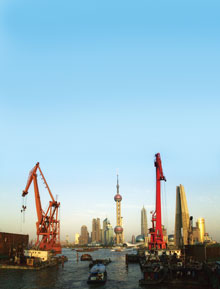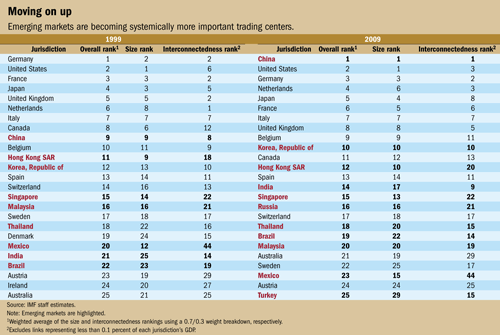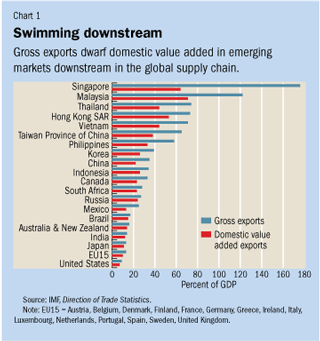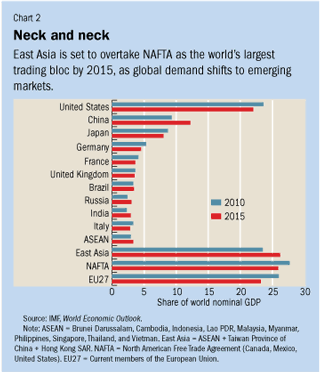Trading Places
Finance & Development, September 2011, Vol. 48, No. 3
Richard Harmsen and Nagwa Riad
Emerging markets are becoming major trading centers thanks to global supply chains and high-technology exports

FOR nearly 40 years, the historic seaport of Rotterdam held the uncontested position of world’s busiest. It was overtaken in 2006 by Singapore, which in turn ceded the title to Shanghai this year. Shanghai now handles more than 29 million standard container units a year.
China is home to 6 of the top 10 busiest ports, mirroring the country’s phenomenal ascent in global trade over the past two decades as it overtook Germany and Japan to become the world’s second-largest trader after the United States. China is the lead player in a move by dynamic emerging market economies from the periphery of global trade to become major systemic trading centers.
Global trade has grown steadily since World War II and accelerated over the past decade, with noncommodity trade—especially in high-technology products such as computers and electronics—rising to more than 20 percent of global GDP in 2008. The expansion in world trade has been characterized by three important trends: the rise of emerging market economies as systemically important trading partners; the growing role of global supply chains; and the shift of higher-technology exports toward dynamic emerging market economies. The convergence of emerging market export structures with those of advanced economies suggests that rising competition from emerging market exporters is likely to continue, with a further growth push as they increase their export sophistication.
Interconnected world
The growing prominence of emerging markets in the global trade landscape reflects not only the total volume of trade (exports plus imports) they engage in but, just as important, the significant increase in the number of partners they trade with (interconnectedness).
Recent IMF analysis (IMF, 2011) uses both measurements—volume and interconnectedness—to rank the world’s top 25 systemic trading centers. Between 1999 and 2009, China moved up nine places to tie with the United States as the systemically most important trading center; India and Brazil moved up seven and three places to rank, respectively, fourteenth and nineteenth worldwide; and Russia and Turkey joined the list (see table). By contrast, France, Canada, and Switzerland have each moved down three places to sixth, eleventh, and seventeenth, respectively. The shift in the relative importance of advanced and emerging market economies has occurred in tandem with growing trade interconnectedness worldwide.

The expansion of global trade as a share of world output—now almost triple the level in the early 1950s—and associated interconnectedness has several causes. Trade liberalization has certainly contributed—by lowering trade barriers first in advanced economies and more recently in many developing countries. In addition, as technological advances led to falling transportation and communication costs, it became more feasible for production processes to be divided up so that countries could specialize in a particular stage of a good’s production (vertical specialization).
This, in turn, led to the emergence of global supply chains. Today, intermediate goods typically cross borders several times before being transformed into a final product. Countries that are downstream in a global supply chain have higher imported content in their exports, because their exports rely on intermediate inputs imported from supply chain partners.
Stronger links in global chains
Vertical specialization in production has implications for the interpretation of trade statistics and for analysis of countries’ interconnectedness—and, in turn, for policy choices.
Official trade statistics are measured in gross terms, which include both intermediate inputs and final goods. Given the rising import content in exports, aggregate trade data are magnified by the flow of intermediate goods that cross borders several times. So tracking the extent and source of imported content in a country’s exports becomes important when gauging the extent of trade and policy spillovers across countries. For instance, for countries such as Singapore that engage in significant assembly and processing trade—that is, using imported intermediate goods to assemble final goods for export—gross exports can account for more than double the domestic-value-added portion of their exports (see Chart 1).

Advanced economies tend to have higher domestic value added—or relatively little foreign content—in their exports. (They are “upstream” in the global supply chain.) Emerging market economies tend to add less domestic value (“downstream”). The relative downstream position of some emerging market economies, including China, reflects the important role of processing trade.
Exports of many emerging market economies stem from processing activities that use mainly imported intermediate goods to assemble final products for export. Such trade accounts for a significant share of exports from China, which together with many other Asian emerging market economies serves as a downstream assembly center in the Asian supply chain. Mexico plays a similar role in North America, hosting duty-free assembly plants that use imported intermediates and reexport final goods back to the United States. And with the accession of eastern European countries—which have lower production costs—to the European Union (EU), production is being outsourced away from the advanced EU economies.
Regional supply chains in Asia, North America, and Europe depend to different degrees on their regional powerhouse, or hub. The Asian supply chain loops through a number of countries, with goods-in-process crossing borders several times, including through the hub (Japan), before reaching their final destination. For instance, about 15 percent of Japanese value added embodied in Chinese products goes through other countries in Asia before reaching China. In contrast, almost all the imported content in North America and Europe is imported directly from the hub—the United States and EU15, respectively. Global supply chains in Asia are therefore more regionally integrated and their export structures more intertwined than those in North America and Europe.
The regional dispersion of the Asian supply chain has important policy implications for Asian traders. Any disruption of trade flows, particularly intraregional trade flows in Asia, could have large negative effects on domestic production in partner countries. The recent earthquake-related disruption in the supply of sophisticated manufacturing inputs by upstream exporter Japan is a sobering illustration (see “Shaken to the Core,” F&D, June 2011). Protecting the free flow of inputs and outputs must therefore be a top policy priority for the region. This could be achieved by making binding the region’s unilateral tariff cuts under the World Trade Organization’s Doha round of trade liberalization negotiations, or including all the key players in regional free-trade arrangements such as the Trans-Pacific Partnership.
Competitor or complement
Global supply chains have allowed emerging markets such as China to increase the technology content of their exports, both as final products and as inputs to high-technology exports of advanced economies, which moves them upstream in the value-added chain. And the share of high-technology exports from China has risen remarkably since 1995, boosted by trade processing and with significant imports from Japan and other Asian countries.
As China and other emerging market economies have become more active in sectors traditionally dominated by advanced economies such as Germany and the United States, their export structures—the types of goods they export—have begun to resemble those of advanced economies. Emerging market countries are therefore likely to compete more with advanced country exporters.
But this observed shift in high-technology content and corresponding convergence in export structures may also reflect complementarity rather than competition, as labor-intensive stages of production are outsourced to lower-wage countries in the region. Even though emerging market economies are exporting products in categories similar to those of advanced economies, there may be differences in quality and price.
In China in particular, the important role the country plays in processing trade in high-technology exports may affect aggregate indicators of export similarity. The export similarity index is an indicator commonly used to gauge a country’s competitiveness, which ranges from 1 for country pairs with identical shares of product categories in their overall export structure to zero for country pairs with completely dissimilar structures. In our analysis, we attempted to account for differences in quality by distinguishing products by destination market, on the assumption that high-income countries are likely to demand higher-quality versions of a product. Based on this modified export similarity index, we found that there is still overlap in the export structures of advanced and emerging market economies. Rising competition from emerging market exporters is therefore likely to continue.
Another growth push?
The ongoing change in export structures suggests that dynamic emerging market economies can look forward to a growth push in the future. Analysis (based on an indicator by Hausmann, Hwang, and Rodrick, 2007) measuring the income level embodied in a country’s exports is useful in gauging the extent of export sophistication. The indicator assigns to each product category the weighted average income level of countries producing the same product. A product produced exclusively by an advanced economy and likely embodying higher quality and value added is assigned a higher value. The results of this analysis suggest that countries whose income value of exports is higher than expected tend to grow more in subsequent years.
Thanks to ongoing upgrading, the overall quality of exports in several emerging market economies is higher than one would expect based on per capita GDP alone. Our updated analysis of the Hausmann indicator thus implies that the growth push is expected to be most pronounced for some Asian countries—such as India and China—and somewhat small but still positive for most eastern European countries.

The integration of rapidly growing emerging market economies is likely to induce a gradual shift in global demand away from advanced economies. China overtook Japan as the second-largest economy in the world in 2010, and East Asian countries are likely to emerge as the world’s largest trading bloc by 2015, surpassing the North American Free Trade Agreement countries (NAFTA—Canada, Mexico, and the United States) and the euro area (see Chart 2). Global supply chains have been an important factor in this trend, and a country’s position along the supply chain could have important implications for trading patterns in the future.
Exchange rates
The emergence of global supply chains may also have changed the way trade responds to relative price changes. The higher the amount of imported content in a country’s exports, the less sensitive trade will be to changes in the exchange rate. For instance, if a country’s currency appreciates compared with that of its trading partners, exports will become more expensive, but imported intermediate goods become cheaper.
Advanced economies—whose exports tend to be concentrated in medium- and high-technology goods—are therefore likely to be more sensitive to relative price changes because their exports have higher domestic content. The converse should hold for emerging market economies.
Indeed, our analysis of the response of sectoral trade flows to changes in exchange rates found that a real exchange rate appreciation of, say, 10 percent, in a downstream country such as China is likely to exert a relatively smaller adjustment in the trade balance than a similar change in an upstream country such as Japan. The rebalancing implications of any exchange rate changes should therefore take into consideration the composition of the country’s trading structure, including how much imported content it includes.
Joining the list
Emerging market economies, led by China, are turning out to be systemically important trading partners, alongside key advanced economies. Their growing trade integration has been accompanied by rising technology content of exports and growing convergence of their export structures with those of advanced economies. And as they continue to grow, the systemic importance of the more dynamic emerging market economies in their respective global supply chains is also likely to increase. More emerging markets making the busiest seaports list? Probably. Stay tuned. ■
Richard Harmsen is a Deputy Division Chief in the IMF’s African Department, and Nagwa Riad is a Senior Economist in the IMF’s Strategy, Policy, and Review Department.
This article is based on a June 2011 IMF paper, “Changing Patterns of Global Trade,” available at www.imf.org/external/np/pp/eng/2011/061511.pdf.
References
Hausmann, Ricardo, Jason Hwang, and Dani Rodrik, 2007, “What You Export Matters,” Journal of Economic Growth, Vol. 12, No. 1, pp. 1–25.
International Monetary Fund (IMF), 2011, “Changing Patterns of Global Trade” (Washington, June).


